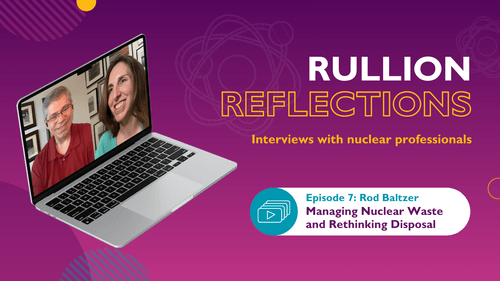Overcoming Talent Acquisition Challenges in the UK Nuclear Industry
As the UK stands on the brink of an unprecedented surge in the nuclear industry, the talent landscape is evolving at an exponential pace, and has never been more critical to the sector’s success. An estimated 300% increase in personnel is predicted by 2050, marking a transformative shift in the sector’s history.
As one of the UK’s leading nuclear industry recruitment provider’s, Rullion is at the forefront of this changing talent landscape, crafting recruitment solutions designed to meet the unique needs of this rapidly evolving sector.
This blog post will delve into the challenges, trends, and innovative strategies shaping the nuclear talent landscape, and how Rullion can guide businesses in attracting, retaining, and developing the talent necessary for success.
Tackling the skill shortage: the demand for specialised talent in the nuclear industry
The nuclear industry has always been a highly specialised sector, requiring a diverse range of skills and expertise.
According to the Nuclear Skills Strategy Group (NSSG) – the UK-wide employer-led nuclear industry skills lead and provides ‘one voice’ to government – the nuclear sector’s growth is tied to a significant demand for a diverse range of skills.
Engineers, welders, technicians, and safety personnel are in critical demand, representing just a fraction of the talent required to ensure the sector’s growth and sustainability.
Despite the allure of highly-skilled, secure, and rewarding careers within the nuclear industry, finding the right people with the right skills in sufficient quantities has become a serious challenge in the industry’s path to growth.
“The nuclear industry is indeed undergoing significant change, and the talent required is diverse, with a range of skills, qualifications, and experiences needed to meet the sector’s unique challenges,” said Shaun Walker, Rullion Principal Consultant.
Overcoming borders: navigating international talent acquisition in the nuclear sector
Furthermore, in a written evidence submission to a parliamentary committee in September 2022, the NSSG highlighted the UK nuclear sector’s struggle to attract international talent. This challenge is intensified by perceived requirements around nationality and residency, uncertainties over energy policy, and non-competitive salary packages when compared with countries like the USA and Canada.
Despite these hurdles, Shaun offered an optimistic perspective: “In the face of these challenges, we find opportunities. As recruiters, we need to leverage our unique strengths in talent nurturing, re-skilling, and network-building to keep the UK’s nuclear sector thriving.”
The crucial role of equality, diversity, and inclusion in the nuclear sector’s future
According to a report by the Nuclear Skills Strategy Group (NSSG), the current nuclear workforce is not as diverse as it should be. For instance, women make up just 20% of the workforce, although the proportion of younger women entering the sector is promising, with 33% of engineering apprentices being female.
The reasons behind this underrepresentation vary, from challenges in recruitment and retention to legacy issues affecting advancement.
Shaun said: “Retaining talent is as important as recruiting it, and we’ve found that a significant proportion of women leave the workforce when starting a family. The sector also has an ageing workforce, with 20% being over 54, so it’s crucial to attract younger talent to ensure a sustainable future.”
But diversity in the nuclear sector is not just about equality; it’s about business sense. A diversity of people brings a diversity of thought, fostering innovation and productivity. The NSSG highlights that diverse organisations are more productive, have greater innovation, and are more capable of doing things differently.
Implementing EDI strategy: enhancing diversity in the nuclear sector
To address the issues of diversity in the sector, the NSSG and its partner organisations have developed a comprehensive strategy. This includes the creation of an Equality, Diversity, and Inclusion (EDI) Strategy and a Nuclear Sector Gender Roadmap.
The EDI strategy involves awareness campaigns and is underpinned by a Nuclear Sector Gender Commitment, signed by senior representatives of nuclear sector employers, government departments, and partner organisations.
Shaun said: “At Rullion, we embrace this strategy and work with organisations to implement it in their recruitment processes. We also help them understand their current position with regards to their EDI by comparing their quarterly EDI stats vs all our other Managed Solutions accounts. By undertaking this exercise, it shows us and them where they’re already successfully incorporating diversity issues and where they can focus their efforts.”
Bridging the gap: promoting EDI for a diverse nuclear workforce
Enhancing diversity and inclusion in the nuclear workforce is an essential part of addressing skills and recruitment gaps.
Significant work has been done by individual employers in the sector to promote EDI. This includes working with local schools and colleges to encourage applications from all sections of the population and inclusive recruitment practices.
“As a recruitment leader in the sector we, at Rullion, play a crucial role in this endeavour,” said Shaun.
“We actively promote the sector’s diversity goals and work closely with our clients to help them achieve them."
Overcoming the STEM talent shortage: innovative approaches in the nuclear industry
A significant aspect of the nuclear talent landscape is the difficulty in recruiting high-calibre talent in various STEM fields. The NSSG evidence underscores this problem, outlining a growing demand for various engineering disciplines, nuclear reactor operations, material science, computational modelling, non-destructive testing, and IT disciplines.
Shaun, in his role at Rullion, has experienced these challenges first-hand: “The STEM shortage in the nuclear industry presents an opportunity to innovate in how we attract, train, and retain talent. There is potential in targeting untapped talent pools, optimising talent development pathways, and cultivating industry-academia partnerships.”
Promoting nuclear careers and STEM education among youth
Further exacerbating the talent shortage is a lack of awareness among young people about the array of STEM careers in the UK. This underlines the need for improved educational outreach and employer engagement in STEM. Degree apprenticeships and T Levels, for instance, could offer robust routes for the development of the nuclear workforce.
Shaun shared: “At Rullion, we’re passionate about bridging the gap between the nuclear industry and the education sector. It’s critical that we work together to ensure young people are aware of the rewarding careers available to them in this field.”
Fostering growth: the imperative of academia-industry collaboration in the nuclear sector
Moreover, improving the quality of academic careers and facilitating exchanges between academia and industry are crucial for the nuclear sector’s long-term growth. Universities and industry players need to join hands to align research with practical needs, ensuring a steady influx of specialists equipped to tackle real-world challenges.
Rullion, as a leading recruitment agency in the nuclear sector, has a critical role to play in this scenario. As Shaun pointed out: “We’re here not just to recruit but to create connections, initiate dialogues, and foster partnerships that will build a sustainable talent pipeline for the nuclear industry.”
“Navigating the nuclear talent landscape is no easy task. But with a firm grasp of the sector's intricacies, a strategic approach, and the dedication to drive positive change, it is a task we can collectively undertake with confidence,” he added.
Charting the future: NSSG’s strategic commitments to overcome the nuclear skills gap
Recognising the challenges, the NSSG, has formulated an innovative approach to tackle the pressing skills gap. Four key commitments form the bedrock of this approach:
- Promoting the national importance of nuclear
- Inspiring and attracting the workforce of tomorrow
- Creating an environment that values the workforce and promotes the industry as a great one to work in
- Advocating for collective action and challenging traditional business practices.
Shaun was enthusiastic about this multi-pronged approach.
“These commitments represent a much-needed shift in the industry’s perception, appealing to future generations and fostering an environment that values its workforce. At Rullion, we fully align with these principles to ensure our recruitment strategies benefit both our clients and candidates in the long run,” he said.
Task and finish groups: agile solutions to address sector-specific skills shortages
An innovative element of NSSG’s approach is the “task and finish” groups. These agile groups focus on diagnosing and resolving skill shortage areas, such as welding, radiological protection, project controls and safety. They analyse, deliver, and evaluate solutions for specific skills areas to ensure sustainable development within the sector.
An example of such efforts, according to an article in the Nuclear Industry Association’s Hub, is evident in the work led by Jamie White from EDF, another NSSG member. He is specifically addressing the lack of welding provision within the sector, a critical skills area that has unique challenges.
Rullion applauds these concerted efforts, as we’re committed to working in line with the solutions offered by these task and finish groups, aiding businesses to attract, retain, and develop the skills necessary for the future.
Cross-industry collaboration: harnessing collective action to overcome the nuclear skills challenge
Collaboration and collective action are at the heart of NSSG’s approach. By fostering cross-industry collaboration, the group is developing 'enabling solutions’ that tackle the skills challenge from multiple angles. These include engaging with school curricula, addressing challenges in vocational education systems, and developing cross-sector secondments to accelerate competence development.
“The power of collaboration and collective action in overcoming these challenges cannot be understated,” Shaun said.
“At Rullion, we’re proud to play our part, leveraging our network and expertise to give our clients access to the best talent, and providing our candidates with the most exciting opportunities in the industry.”
Government and industry synergy: catalysing diversity in the nuclear sector
The NSSG report suggests further actions that can be taken by the UK Government, UK Research and Innovation, and other funding bodies to improve diversity in the nuclear sector. These include facilitating and coordinating data gathering on diversity issues, encouraging and facilitating organisations to develop comprehensive diversity-related action plans, and providing support and funding for STEM employers to work with schools and colleges.
“In a sector where cutting-edge science and technology are essential, we need to ensure that we have the best possible talent,” said Shaun.
“That’s why at Rullion, we’re committed to helping organisations navigate the nuclear talent landscape, ensuring that they attract, recruit, and retain a diverse range of skills and expertise.”
Powering the future: Rullion’s pivotal role in nuclear talent recruitment
Navigating the nuclear talent landscape is no small feat. Yet, with a clear understanding of the landscape, a commitment to collaboration, and a dedicated approach, we can unlock the potential of the nuclear industry.
As we stand on the cusp of significant growth within the sector, Rullion remains the trusted recruitment partner for the nuclear industry. Our specialist knowledge, extensive experience, and unparalleled network make us uniquely positioned to meet the growing demand for skills and talent in this sector.
Contact us by filling out the form below to learn more about how we can support your recruitment needs in the nuclear industry. Together, we can power the future of nuclear energy.





